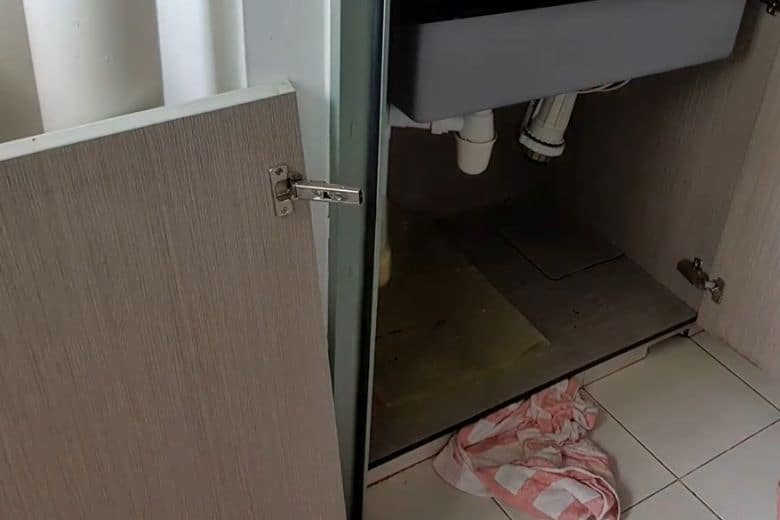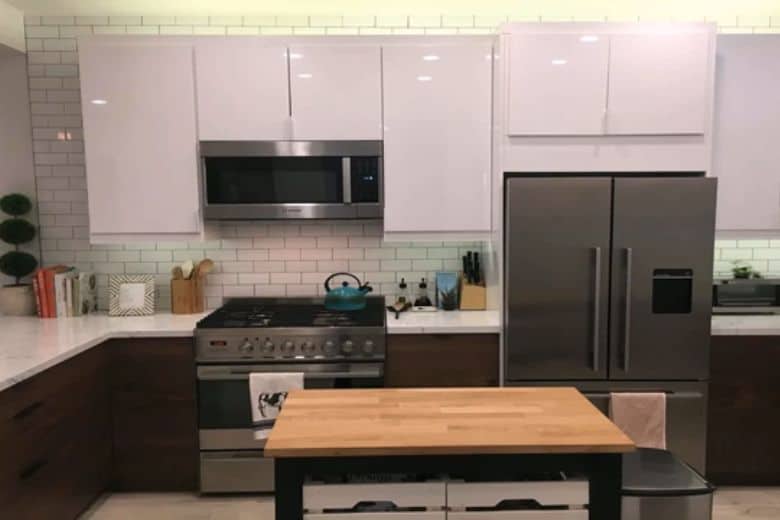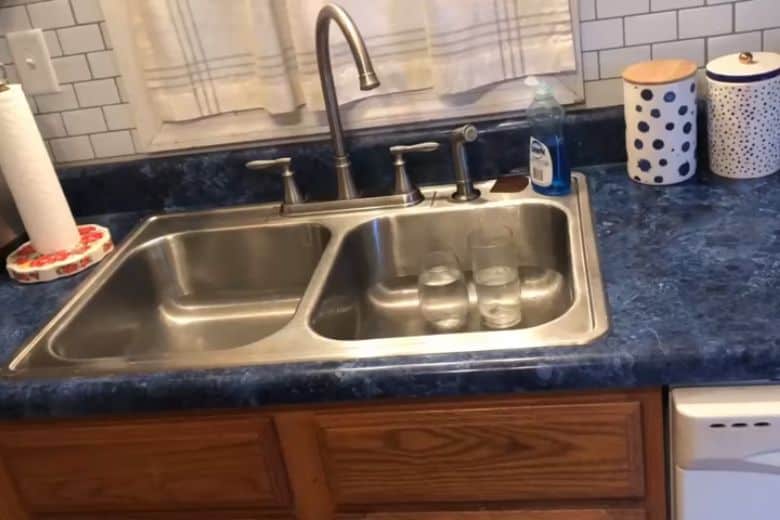You open the kitchen cabinet to find something. Unfortunately, a leaky and damp kitchen cabinet greets you instead of what you’re looking for there. Undoubtedly, the scene isn’t pleasing at all. You would also get bamboozled to see water under the kitchen sink cabinet.
At that time, you may wonder why is water leaking under kitchen cabinet. Also, sometimes you may see water under the kitchen sink but no leak. There’re multiple reasons for water under the kitchen sink cabinet.
The seal between the kitchen sink faucet and water line can be damaged or loose, defective faucet, loose aerator, problems with the water supply lines, etc. Also, leaks happen because of leaky garbage disposal, dishwasher parts, worn-out washer, and sprayers.
You need to identify the actual cause by inspecting the kitchen sink and its different parts. After identifying the problem, you can solve it following our suggestions.
The 7 Reasons for Water Leaking Under Kitchen Cabinet:
When you see water leaking under the kitchen sink cabinet, you must identify the cause immediately. The longer you take time to find the reason for leaks, the more the system gets damaged. Thus, it increases the repairing cost.
1. Loose Screw Nuts:
Both hot and cold water lines run underneath the kitchen sink cabinet. Hence, multiple nuts hold these lines together. Over the years, rust and corrosion may loosen the nuts. Also, they get loose due to friction.
Also, the nuts will be in drain lines that can get loose too. You must check the screw nuts for drain pipes and water lines. If you find any nuts loose and water dripping around them, you need to fix them. You can tighten the screw. Also, apply Teflon tape around the nut after tightening it.
2. Worn-Out Sprayers and Washers:
Washers seal the connection of your plumbing system to make it watertight. It gets hardened when you haven’t changed the washer for a long time. As a result, the washer becomes ineffective. When the washer becomes ineffective, it loses its watertight property. So, water starts leaking around the sink’s washer.
Similarly, the sprayer gets damaged due to rust, corrosion, and usage. If tightening the nuts doesn’t work, you must check the sprayer and washer connection if tightening the nuts doesn’t work. You need to replace the washer or sprayer if it causes leaks.
3. Defective Shutoff Valves:
Shutoff valves allow you to shut down and turn on the water supply directly to the kitchen sink faucet. It has an O-ring and gaskets that seal the valves against the water supply lines. The rubber-made O-ring will wear out after 10 to 15 years, causing leaks. Henceforth, you must replace the O-ring or gasket under the sink cabinet. Once you replace the gasket or O-ring, the connection will regain its watertight properties. Thus, you won’t see a leaking water line under the kitchen sink.
4. Damaged Water Lines:
Sometimes you will see the water coming under your kitchen floor. At that time you should know why water is coming from under my kitchen floor. Usually, it happens because of the leaks in the water lines.
You need to check the water line carefully for damages and leaks. If you find leaks in the water line, you can apply Teflon or plumbing tape to stop the leaks. However, it is a temporary solution. You need to call a plumber to fix the leaky water lines for a permanent solution.
5. Leaking P-Trap:
A p-trap prevents the odor from coming from the sewage line into your kitchen. Also, it sits in the middle between the sink and drain lines and holds water. The water stops the odor from coming inside to ensure hygiene in the kitchen.
Unfortunately, the p-trap gets damaged or starts leaking due to overuse. Usually, the p-trap leaks after 10 to 15 years of use. You must replace the unit when you see such a leaky p-trap connection.
Also, different components of the kitchen sink P-trap may wear out over the period. It includes O-ring, gasket, or screw nuts. So, you need to inspect the different components for damages. You need to reseal or replace the O-ring washer or gasket. You will need a plumber’s putty to seal the gasket or washer. Or, you may use Teflon tape to seal the connection.
6. Defective Faucet and Faucet Connections:
Sometimes the culprit of leaking water under the sink cabinet can be the faucet itself. The faucet can develop leaks, internal damage, or cracks as it ages. Also, one or multiple parts of it may fail. When it happens, water will drip through it underneath the sink.
If you don’t fix the internal parts of the faucet, the problem will become bigger. Thus, you must observe the faucet and replace the damaged parts. The problem mainly happens because of a damaged aerator or gasket.
7. Problems With the Garbage Disposal and Dishwasher Line:
Over the period, the connection between the garbage disposal and kitchen sink will become loose. Also, the dishwasher line may become loose or damaged due to rust and corrosion. Also, leaks may develop there due to loose connections.
You need to check the dishwasher line and garbage disposal to find the reasons for the leak. After that, you will need to fix it.
5 Workable Solutions for Water Leaking Under Kitchen Sink Cabinet:
In the previous section, we have described the possible reasons for the leaky kitchen cabinet under the sink. So, it’s high time we talk about the solutions.
1.Fix the Gasket and Seals:
In most cases, leaks happen due to a damaged O-ring or gasket. Thus, you should replace the washer or O-ring to stop water leakage. You need to buy a new rubber washer or gasket of a similar size to replace it with the previous one.
2. Fix the Defective Faucet:
If there’s any defect in the internal parts of the kitchen sink faucet, you should replace it. Thus, you must observe the sink aerator and sprayer to identify the causes of the leaks. You must turn off the water line to replace the aerator or sprayer. Also, take a picture of the aerator or sprayer to get the similar one from the plumbing store.
3. Fixing the Water Lines:
Sometimes leaking water line under the kitchen sink will moisten the floor. Unfortunately, you can’t fix the leaky water line problem permanently. You can apply a plumber’s tape to the leakage to stop water from dripping out of it temporarily.
The plumber’s tape can stop the water leaks for the time being. But, you must call a plumber to fix the problem permanently. The plumber will use copper or aluminum to seal the leaky area. Depending on the damage level, it may cost you around $100 to $350.
4. Replacing the P-Trap Components:
At times, the P-trap connection’s gasket, O-ring, or rubber washer will become loose. It will cause leaks too. Thus, you need to check the different components of the P-trap and its connections. You can use a paper towel to find the leaks closely.
After that, you need to take the necessary action. If the gasket or O-ring has worn out, you need to replace it with a new one. Also, for the loose nuts on the p-trap, you must tighten them.
5. Tightening the Loose Nuts:
Get an adjustable wrench first. Connect it with the loose nuts to tighten it. Try tightening it slowly once you have connected the wrench or pliers with the nut. You need to be careful to avoid damaging the screw nut’s threads. Or else you will have to replace the nut.
Frequently Asked Questions:
How much does it cost to replace pipes under the sink?
Answer: The average cost of replacing the waterlines under your kitchen sink cabinet is $100 t0 $350. Depending on the type of water supply lines you use and the plumber’s wages, it may increase.
Why I can’t get P-trap to stop leaking?
Answer: A p-trap will leak continuously because of loose screw nuts, incorrect positioning of the washer, or misaligned pipes. So, you will have to observe these components.
Can water seeping through the laminate floor?
Answer: If water stays over the laminate floor for too long, water can seep through it. Thus, you will need to stop water from staying over the laminate floor too long.
Conclusion
When you see water leaking under kitchen cabinet, you must observe it closely. Since there’re multiple kitchen sink components, you need to check them one by one. More importantly, leaks happen because of loose nuts, damaged connections, or worn-out seals. You will need to apply different techniques to stop water leakages underneath the sink cabinet.
Paul Newman is a blogger who writes about plumbing and home improvement. Over the past 20 years, I have worked as a plumber. My passion is to share my knowledge and experience with others to improve their homes.




